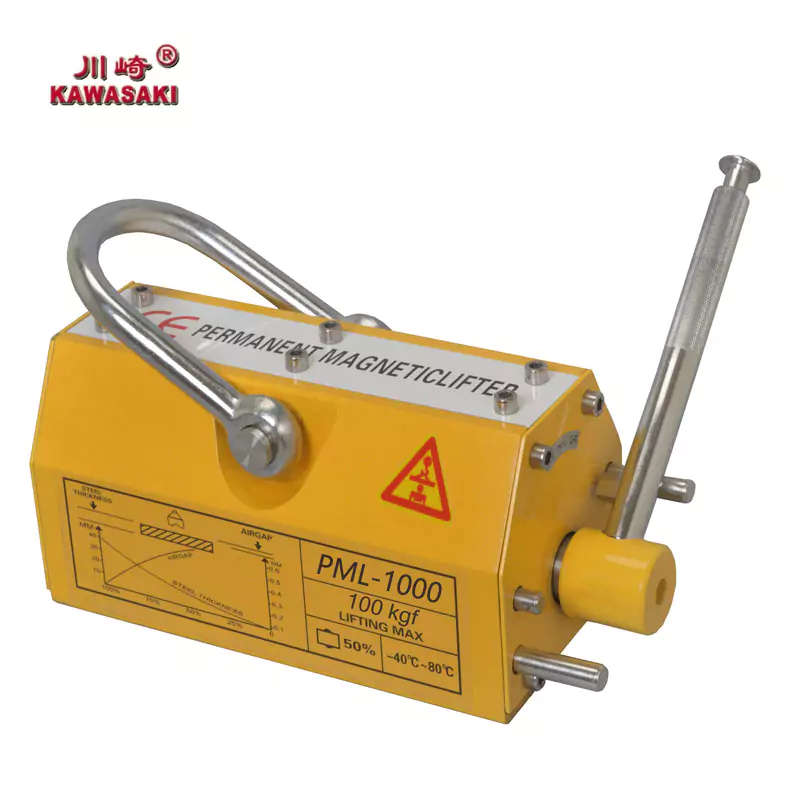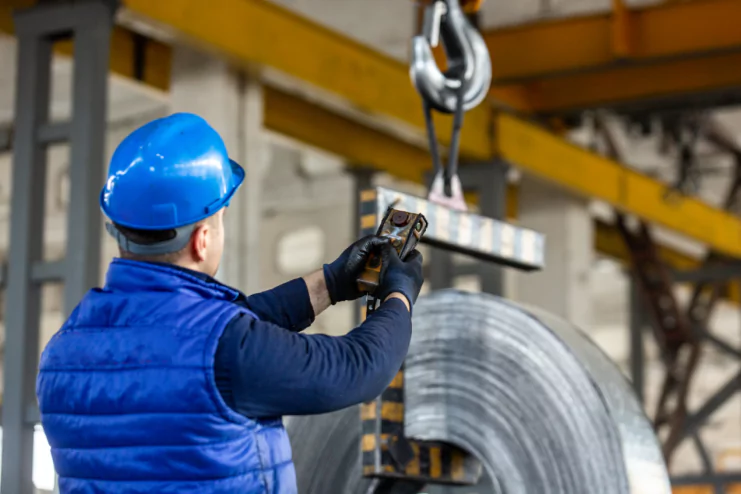Lifting magnets used in settings harness the power of magnets (either permanent or battery-powered electromagnets) to safely raise and transport ferrous objects like steel sheets and pipes at construction sites and warehouses. APOLLO‘s advanced lifting devices feature neodymium magnets for a grip, along with safety mechanisms and a safety margin of 3.5x to avoid unintended release of the load. When operating these lifters in the workplace, it’s crucial to follow the specified weight limits for each model and maintain contact surfaces alongside regular inspections every 500 hours to guarantee that safety and functionality are upheld properly. These tools adhere to ISO 9001 and CE standards. Perform admirably in challenging conditions like dusty surroundings and varying temperatures without causing significant damage to the materials they handle. Their V-shaped patterns enable them to handle flat objects with greater flexibility and effectiveness, requiring operators to undergo training to prevent accidents, such as objects slipping off these tools.
What Are Lifting Magnets?
How Do Magnetic Lifters Work?
Magnetic lifters are utilized in a range of industries to lift and transport heavy metal items through the power of magnets without the necessity for physical contact like what traditional clamps or chains would demand. This approach aids in safeguarding material integrity during handling. It is highly appreciated for its efficiency and efficacy in tight spaces where usual equipment may face challenges in delivering optimal performance.
Which Types of Lifting Magnets Are Available?
Different varieties of lifters exist to serve distinct purposes and applications, divided into three primary categories.
Permanent Magnetic Lifters
These devices utilize materials such as neodymium iron boron (NdFeB) to generate an durable magnetic field without requiring external power sources for functioning effectively This makes them reliable and economical choices for lifting operations in different sectors such, as manufacturing and construction wherein flat or cylindrical steel objects are required to be lifted effortlessly utilizing their innate magnetic properties that prove beneficial particularly when managing round or flat steel items with the aid of a distinct “V” shaped surface design found in certain models.

Electromagnetic Lifters
Electromagnetic lifters use electricity to generate a field that can be customized by adjusting the current flow to suit various loads and weights efficiently, but may face constraints when the power supply is not stable.
Battery-Powered Magnetic Lifters
Battery-operated lifting devices combine the advantages of electromagnets with the convenience of battery power, making them perfect for environments where a steady power source is unavailable while needing the flexibility of adjustable magnetic strength.
Are There Risks When Using Lifting Magnets?
What Operational Hazards Exist?
Using lifting magnets comes with benefits, but can also pose risks if not handled properly.
Load Slippage or Detachment
One significant risk involves the possibility of a load slipping or coming loose, which may occur when the weight surpasses the magnet’s capacity or when the contact surface is unevenly textured and therefore not secure enough to hold it firmly in place as required by safety standards.
Environmental Factors
Conditions like temperature changes, dust, or moisture can impact magnet performance. For example, extreme heat may gradually weaken magnetic strength. Dust buildup can hinder proper surface contact.
Is Maintenance a Safety Concern?
Keeping up with maintenance is crucial to ensure the operation of lifting magnets. When parts wear out. Magnets weaken, and handles get damaged, which can put safety at risk. Neglecting inspections increases the chances of equipment failure.
How Can You Safely Use Lifting Magnets?
What Guidelines Should Be Followed?
To maximize safety when using lifting magnets:
Adhere to Weight Capacity Limits
Always follow the manufacturer’s weight capacity guidelines for the lifting magnet model. Overloading can cause detachment and lead to accidents.
Ensure Clean Contact Areas
Ensuring there is a level surface between the magnet and the object is important for maintaining strong adhesion. Dirt, rust, or any surface irregularities can reduce the grip and raise the chances of slipping.
Why Is Regular Inspection Important?
Regular check-ups help detect issues before they escalate into problems. With examination of parts such as grips, latches, and magnetic areas, it guarantees consistent dependability.
How Does APOLLO Enhance Safety in Magnetic Lifters?
APOLLO focuses on promoting user safety by prioritizing design and sturdy construction in its magnetic lifting solutions.
What Features Mitigate Risks?
APOLLO items are equipped with advanced safety features like locking handles with safety buttons for safe use and lasting magnetism powered by high-performance NdFe materials, ensuring consistent performance over time and enabling lifting weights of up to 3 times their rated capacity safely.
Why Are They Reliable in Tough Conditions?
APOLLO lifters are built to last in conditions where dust and temperature changes are common occurrences. They are lightweight yet strong enough for handling without compromising on durability.
Which Products Suit Specific Needs?
When it comes to using flat steel in different applications, the APOLLO Permanent Magnetic Lifters stand out as a great choice. Their unique “V” shaped surface design makes them versatile for handling various shapes of materials.
Industry Standards and Compliance for Lifting Magnets
What Safety Regulations Govern Magnetic Lifters?
Safety regulations for magnetic lifters are crucial for safe and effective operations. These rules focus on load limits, operating conditions, and maintenance needs. Standards like ISO 9001 and CE/GS certifications outline quality and safety requirements. They ensure lifting equipment meets strict safety protocols, reducing risks. Operators must also comply with local workplace safety laws to prevent mishaps due to improper use or equipment failure.
How Do APOLLO Products Align with These Standards?
APOLLO’s magnetic lifters are designed to comply with global safety standards. Each unit undergoes thorough factory testing to confirm its lifting capacity, stability, and safety features. High-performance Nd-Fe-B materials ensure reliable magnetism. A safety coefficient of up to 3.5 times the rated load adds security. Advanced locking mechanisms keep loads stable, even in tough conditions.
The Role of Training and Expertise in Reducing Risks
Why Is Operator Training Crucial for Safe Magnet Usage?
Training is critical for safe magnetic lifter operation. Untrained workers may misuse equipment, causing accidents like load detachment or material damage. Training should cover weight limits, environmental factors, and maintenance practices. Hands-on experience with specific models is also vital for safe handling under diverse conditions.
Which Best Practices Are Shared by Experts in the Field?
Experts emphasize several best practices for safe magnetic lifter operations:
- Pre-Operational Checks:Always inspect the magnetic surface for wear or damage before use.
- Load Distribution:Ensure that the load is evenly distributed across the magnet’s surface to maximize adhesion.
- Environmental Adaptation:Use lifters designed for specific conditions, such as high temperatures or dusty environments.
Implementing these methods not only improves safety. Also extends the longevity of the machinery.
Advancements in Technology to Improve Lifting Magnet Safety
What Innovations Are Integrated into Modern Magnetic Lifters?
In recent years, advancements in technology have greatly enhanced the safety components of contemporary magnetic lifting devices, showcasing notable improvements in their features and functionalities.
- High-Performance Materials:The integration of Nd-Fe-B magnets provides a stable and robust magnetic force while reducing device size.
- Safety Mechanisms:Features like locking handles with safety buttons prevent accidental disengagement during operations.
- Design Enhancements:The “V” surface design on some models allows for versatile applications involving both round and flat steel objects. This innovation ensures adaptability across diverse industrial needs.
The latest improvements have made contemporary magnetic lifters more dependable and easier to use when compared to conventional choices.
FAQs
Q1. What types of materials can magnetic lifters handle?
A: Magnetic lifters are effective only on ferromagnetic materials like iron or steel, but not on non-magnetic metals such as aluminum or copper.
Q2. How often should you inspect a lifting magnet?
A: Monthly inspections or checks after every 500 hours of operation are recommended to maintain optimal performance.
Q3. Are APOLLO’s magnetic lifters suitable for extreme conditions?
A: Yes, their durable construction and advanced materials make them reliable even in challenging environments involving dust or temperature variations.

